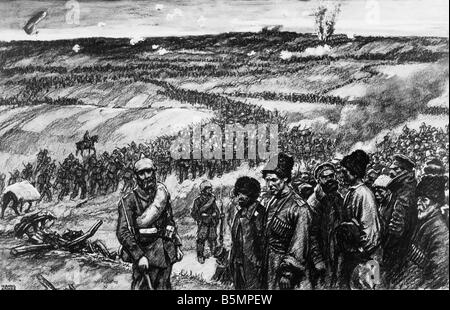
The battle started with a preliminary bombardment on 22 April, and the attack on Ypres started soon after the bombardment died down, but not in the normal fashion. Some have argued that the Ypres battle only went ahead so that Falkenhayn could try out the new gas weapon and at the same time ‘iron out’ the salient around Ypres for a future attack on the coast. This was particularly so after the defeats suffered by the Russians at Tannenberg and the Masurian Lakes. The reason for the Second Battle of Ypres being the only major German offensive of the year was that the new Chief of Staff, General Falkenhayn had been convinced into thinking that a breakthrough on the Eastern Front would be a much more achievable option. Gas had been used on the Eastern Front at Bolimov but the weather had been so cold that it had frozen. It was the only real German offensive on the Western Front for the whole of 1915 and it was the area where gas was first used as an affective weapon.

The second battle is significant for a number of reasons. The Ypres Salient was to be one of the most fought over areas of the whole war. Other Ranks: Killed 36, Wounded 110, Wounded and Missing 31, Missing 721. Officers: Killed 4, Wounded 5, Wounded and Prisoners 2, Wounded and Missing 1, Missing 4. The total casualties during this last tour in the trenches from 4th May till 9th May were:. The remainder of the Battalion were withdrawn from the front line and sent back to the huts. retired through the POTIJZE line and some remained in the trenches till the 9th May.Ĭasualties of the Brigade. Grover, wounded and prisonerĪfter the retirement regiments got mixed up. The following officers were present during the engagement.Ĭaptain C. on the North of the YPRES - ZONNEBEKE Road. was ordered to retire first followed by the 3 platoons of “C” Coy. Major Clough assumed command on the death of Colonel Martin.ġ1.35 a.m.

The enemy were observed moving in a westerly direction on both flanks of the position. under Captain Forwood at once moved across the road and occupied some old trenches east of the burial ground in the rear of the Monmouth’s trenches.ġ0 a.m.Ğnemy commenced attack in the support dugouts but were held in check when 200 yards from them.

3rd Monmouths called for one company to support the line and “B” Coy. The enemy advanced and captured the front line trenches, they then advanced against the support dugouts. 7 a.m.Ğnemy shelled trenches blowing them in, and rendering them untenable. Enemy shelled trenches intermittently.Ĩth. acting as support to the 3rd Monmouths.ĥth -7th.ěn. The trenches were new trenches and had not been completed. marched out and took over trenches in front of FREZENBERG. Orders were received to march out to the trenches and relieve the 5th Bn. The following reinforcements arrived on the 3rd May. The war diary is pretty sketchy - there was hardly anyone left to provide a comprehensive account.Įxtract from the War Diary of the 2nd Battalion, King’s own Royal Lancaster Regiment.Ĥth. This meant that when the German counter-attack was launched, instead of finding a mass of exhausted and disorganised men at the limit of the Allied advance, they would find a well organised defensive line still in range of supporting artillery.Some details on the action Basil Lelliott was killed in (the worst day in the history of the King's Own and, I believe, the most fatalities suffered by any battalion on a single day during WW1). It meant that British soldiers did not move beyond where they could be supported. In addition, they were aided by more and better aircraft carrying out air defence, artillery observation and ground-attack sorties. Using this tactic became possible when more artillery was deployed, thanks partly to the ground drying out between late August and September.

The original attackers would then consolidate the ground they had taken, and become the new reserve for future advances. At this point they would dig in, and another wave of attacking troops would pass through them to attack the next objective. The advancing troops would stop once they had penetrated 1,500 yards into the German lines. This would be heavily shelled and then assaulted in strength. With the British Army's earlier attempts to break through on a wide front having been halted by the deep German defence system, Plumer instead selected for attack a small part of the German front line. The Battle of the Menin Road (20-25 September 1917) witnessed the first use of General Herbert Plumer’s ‘bite and hold’ strategy as the British tried to regain the initiative.


 0 kommentar(er)
0 kommentar(er)
